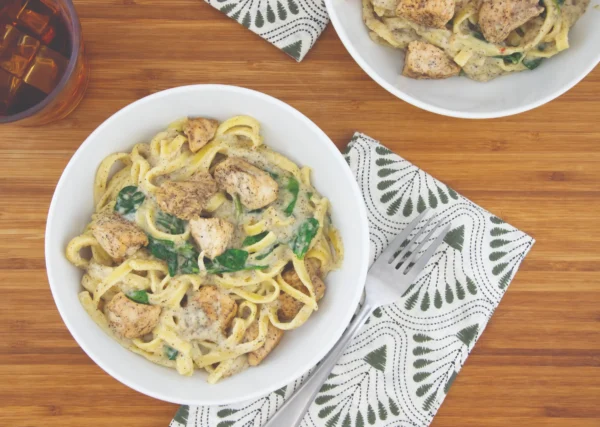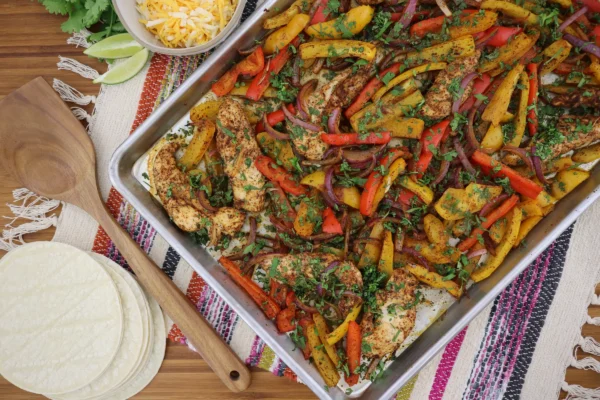“Meal prepping” is the latest trend on social media, but what does it actually mean?
Simply put, meal prepping refers to cooking food in advance and storing it for future meals. Traditionally, meal prepping involves preparing individual food containers, but it can also include ingredient prepping—organizing and preparing ingredients in advance to simplify weeknight cooking.
Table of Contents
- What is grab-and-go meal prepping?
- How to begin grab-and-go meal prepping
- What is ingredient meal prepping?
- How to begin ingredient meal prepping
- Examples recipes for each method
Why Meal Prep?
Meal prepping will save you time and money, reduce mealtime stress, and minimize food waste, all while making healthy choices easier.
If you want to avoid expensive fast food, save money on your grocery bill, and eliminate the daily “what’s for dinner?” question, meal prepping may be the perfect solution.

Adopting this habit can be challenging, especially if you’re cooking for multiple people or if those individuals prefer not to eat the same meal more than once a week. However, there are ways to adjust meal prepping to fit your lifestyle.
What Do I Need to Start Meal Prepping?
- Storage containers – Begin with what you already have instead of purchasing new items. Resealable plastic bags and old takeout containers work perfectly, and you can upgrade later if you discover that meal prepping is a good fit for you.
- Refrigerator
- Grocery list – more on this later!
Two Types of Meal Prepping
First, figure out which meal prep style (outlined below) works for YOUR life. Then, follow the steps to incorporate it into your weekly routine.
Reflect on your biggest problems around mealtimes: are you constantly running out of time in the morning and missing breakfast? If so, begin with preparing grab-and-go breakfasts. Do you have a child who doesn’t enjoy eating the same dish for multiple meals? Focus on ingredient prepping.
1. Grab-and-Go Meal Prepping

This method involves preparing several individual, grab-and-go meals to heat up or eat cold later. For example, someone might cook their lunches for the entire week on Sunday, eliminating the need to pack a lunch every morning for work or school. Alternatively, you can prepare a large batch of food and portion it into bowls to eat when ready at home.
Pros of Grab-and-Go Meal Prepping
- Easy, convenient, and quick
- Save time by making several meals at once
- Reduce the number of dishes to clean after cooking
Cons of Grab-and-Go Meal Prepping
- Requires more space to store pre-prepared meals
- Requires more storage containers
How To Begin Grab-and-Go Meal Prepping
- Start small
Start with one meal of the day—breakfast, lunch, or dinner. This approach will help you ease in without feeling overwhelmed.
- Make your menu
This is the most important part. You MUST know what you will cook to plan your grocery trip accordingly – unless you enjoy extra hassle to pick up forgotten ingredients! Choose recipes that reheat well: my favorites include pasta, soups, and taco bowls. Inspiration can be found in the Meal Prep Recipe Ideas section below.
- Make your grocery list
Review each recipe to identify ingredients you already have, and create a list of any remaining ingredients you need.
4. Prepare your recipes.
Set aside a couple of hours for meal prep, but as you practice this method you will find yourself becoming quicker over time. Try multitasking: for example, cook pasta on the stove while chicken is baking in the oven. Once the food has cooled down, portion it into individual containers and store in the fridge for 3 to 5 days.
Tips to keep in mind:
- Start with familiar, easy recipes. Does your grandma have a chicken noodle soup recipe you can make by heart? If so, begin with that.
- When trying a new recipe for the first time, prepare enough for just 2-3 days’ worth of meals.
- Choose a specific day of the week to prepare your meals, such as Sundays or Wednesdays.
Consider this method if you relate to any of the following scenarios:
- You have enough storage space for grab-and-go containers.
- You prepare meals for a maximum of one to two people: since this method uses an individual container for each meal, finding room in the fridge for multiple family members for multiple meals of the day can prove challenging.
- You often eat meals outside of the house.
- You only want to use this method for one mealtime per day – for example, you want to make breakfast ahead of time, but not lunch or dinner. Again, this is to limit the amount of storage containers you use.
- You have limited time.
- You frequently eat the same meals, such as breakfast every day. Cooking a large batch will save you time!
Do you often run out of time in the morning to make breakfast or pick up last-minute fast food for lunch? A grab-and-go container may be just what you need. This method may not suit every mealtime and schedule, so adjust to fit your needs.
2. Ingredient Meal Prepping

This method of meal prepping allows you to prepare fresh meals quickly by cooking the ingredients in advance, making them fast and convenient to assemble.
Examples include…
- Cutting or steaming vegetables
- Marinating meat
- Cooking a batch of pasta or rice
- Assembling a casserole ahead of time (to cook later)
If you need an onion for two different recipes, you can simplify the process by slicing both at once rather than on two separate days. This way, when it’s time to cook your weeknight meal, you can easily grab the onions from the fridge.
Pros of Ingredient Meal Prepping
- Less time spent on clean up (as fewer dishes are used)
- Practical for those who prefer fresh-cooked meals daily
- Save money on groceries by using the same base ingredients in several recipes
Cons of Ingredient Meal Prepping
- Less convenient than grab-and-go meal prepping since you prepare fresh meals daily
How to Begin Ingredient Prepping
- Make your menu.
Create variety in your meals by using similar ingredients in recipes with contrasting flavors. For example, if you bought chicken breast in bulk, you could create a chicken pasta recipe, chicken noodle soup, and chicken curry in your weekly menu using different flavors and spices. If you buy ground beef, you could create lasagna and tacos.
This can also be done with vegetables: for example, you could serve steamed broccoli as a side one night and make broccoli cheddar soup another night.
- Decide when.
Find a day to set aside 1-2 hours, depending on how many recipes you plan to prepare for.
- Create a grocery list.
Write down the ingredients needed for each recipe and create a grocery list of items you don’t already have.
- Plan your prep.
Identify which steps of the recipes can be completed in advance, and make a list of tasks to accomplish during your dedicated meal prep time to stay focused.
- Store ingredients.
Keep ingredients in reusable containers or plastic bags. Gather as needed throughout the week to create your dishes!
Consider this method if you identify with any of these scenarios:
- You are cooking for three or more people
- You or your family prefer a variety of meals over saving time
What is the Best Method?
There is no perfect answer to this question. Many people choose to use a combination of these two approaches!
For example: every Sunday, I prepare my lunches in individual containers for an easy grab-and-go option. While I’m preparing my lunches, I also chop vegetables or cook meat for various dinner recipes that I’ll prepare fresh throughout the week.
Meal Prep Recipe Ideas
Let’s explore examples of grab-and-go meal prepping and ingredient meal prepping, focusing on a two-day plan for breakfast, lunch, and dinner for each method.
Grab-and-Go Two-Day Meal Plan
Green Chili Migas
Breakfast Day 1 and 2

Wait to add the tortilla chips until you are ready to eat!
Sesame Salmon Bowl
Lunch Day 1 and 2

Easy Skillet Lasagna
Dinner Day 1 and 2

Ingredient Prep Two-Day Meal Plan
Pumpkin Muffins

Breakfast Day 1
These two muffin recipes are surprisingly different, yet they share common ingredients. Both recipes include milk, eggs, and Greek yogurt, which means you won’t waste money on unused groceries.
Cheesy Breakfast Muffins

Breakfast Day 2
To prepare for your cheesy breakfast muffins, chop the bell peppers, cilantro, and mushrooms in advance.
Italian Orzo Soup

Lunch Day 1
Meat is the most expensive part of a meal. Luckily, both of these delicious recipes feature turkey, so you save money by buying in bulk!
Southwest Turkey Meatballs

Lunch Day 2
Change up the flavors when using similar base ingredients, and you’ll never get tired!
Creamy Chicken Alfredo

Both dinner recipes include chicken breast, and you’ll find ingredients such as cilantro, spinach, parmesan, and bell peppers are also utilized in the breakfast and lunch recipes mentioned earlier.
Chicken Fajitas

If you’re low on time, cook your chicken breast in advance and add to each recipe afterward.
Conclusion
Here you have it: a beginner’s guide to learn how to master your meal prep. If you want to see more blogs like this, comment “YES” to let us know!


